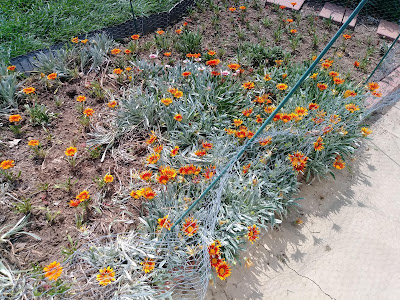Of course, I don't have enough money to remodel my kitchen. But my cabinets were looking tired, old, and dated. They are good quality -- Woodmode, solid maple (doors and drawer faces) -- and a classic, timeless design, but the finish -- "Champagne Maple" -- was dated, from the early '90s, worn down from years of scrubbing, scratched, and yellowed from age and cooking fumes and splatters. So I decided to paint the cabinets to modernize the kitchen.
 |
| Before |
 |
| Before, Closeup of wear to finish |
Anne, my decorator friend, was getting her house ready to sell, and she wanted her cabinets painted, too. She got some estimates for having it done professionally, but was astounded at the quotes -- something like $7000-$10,000. She has a lot of cabinets, but still . . . . We both decided to do it ourselves: How hard can it be? You just have to use the right primer.
Famous last words.
I chose Benjamin Moore's "Hazlewood" color on their Advance quality of paint. The Advance paint is made to "level" (not streak or clump), and is recommended for cabinets. White is the color of the day, but, again, Anne had her (correct) opinion: White would give too much contrast between the cabinets and the countertops. The Hazlewood color had just the right amount of grey and mushroom to marry and enhance all the colors of the kitchen -- the forest green countertops, the light green walls, and the stainless steel appliances.
To start, I had to remove all kitchen cabinet doors, drawer fronts, and hardware. Also, my cabinet doors came with "dust guards," rubber strips along the left side doors. These had to be removed with a glue solvent and putty scraper, on advice from the cabinet manufacturer.
 |
| Dust guard (from inside door). Dust guard lip extends abt. 1/4" from edge of door, to cover space between two cabinet doors. |
The first thing I had to do was paint the inside of the large cabinet next to my refrigerator. That cabinet had been replaced, due to damage to the original cabinet, and the cabinet maker used maple wood inside the cabinets, to match the maple wood on the outside of the cabinets. But all the other, original cabinets, had simple, almond-colored, pressed-wood (or like) insides and shelves. Plus, the maple color would clash with the color I had planned for the doors and drawers.
So I had to paint the inside of that cabinet to match the insides of the other cabinets. Mistake No. 1: If I had been smart, I would have brought a shelf in to the hardware store, to have the color custom-matched. Instead, I did bring a shelf in, but I just used it to choose a color, Behr Mourning Dove (Eggshell), that looked like a good match. Unfortunately, though, once I painted the first coat, I realized it was too light, so I had to blend a new color from paint I already had, and paint two more coats. From my notes, it appears I started with about 5/8 pint of the Mourning Dove, and added about 1/3 cup of my cabinet door color. It was a pretty good match, but it would have been better custom-blended, it would not have cost any more, and I would not have wasted time on the first coat of paint.
 |
| Paint to the exterior cabinet frames. Note: I used a razor to keep paint from clogging between the panels, to keep an even appearance. |
Mistake No. 3 was not experimenting more with the application process. I ended up using mostly brushes, because my cabinet doors and drawer fronts have bevelling and molding that would make roller-brushing uneven. But brushing takes time, and requires more coats. If I had a do-over, I'd try spray-painting. I might not choose it, but I'd at least try.
Mistake No. 4: Not a biggie, but I should have put some wood putty between the edges of the molding and the panel before I started painting. If you look closely at this picture (maximize to actual pixels), you can see where the paint is unevenly applied to the crease. I fixed it by adding the putty after the second coat of paint, but that meant I spent more time adding paint to the edges to cover the putty. Had I done the putty before painting, there would have been no need for the extra dabbing of paint.
I decided now would be a good time to replace my over-the-stove microwave. I was not in a hurry to replace it, all things being equal. The heating element didn't work, but the exhaust worked fine, and I had a countertop microwave. But it would need to be replaced eventually, and removing it now would allow me to paint the sides of the surrounding cabinets, and the wall behind. As a happy bonus: it also made it much easier for me to clean and stain the backsplash grout and tiles.
The whole process was time-consuming: I started around the beginning of September 2018, and didn't finish until four months later, early January 2019. Another Christmas consumed by DIY projects. But it was worth it. Behold the finished product. Note, I also replaced the cabinet hardware (door and drawer handles), and, not shown, I also replaced the kitchen faucet.
Update 8/19/19: The cabinet door hinges needed to be adjusted for alignment. I found this article to be helpful in explaining which screws need to be turned in which direction to adjust the doors up or down, in or out.









































